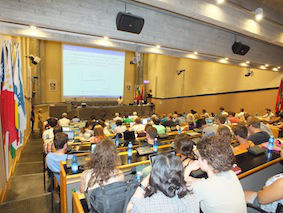Speaker
Description
Abstract: A century after the original discovery of Cosmic rays, full details of the origin and transport of cosmic-Ray nuclei remain unclear. The production of elements (nucleosynthesis) by stellar fusion is very well established and there is good reason to consider Supernovae (SN) shocks as the most likely accelerators of cosmic rays. However, for elements heavier than about Z=30, Fusion cannot account for observed cosmic-ray abundances. Thus relative abundances of ultra-heavy galactic cosmic rays (UHGCR), with Z>30, probe other nucleosynthesis processes as well as the ways in which those nuclei are injected into the cosmic accelerators. The nucleosynthesis of elements with Z≥36 is almost entirely a mixture of two neutron-capture processes: the “slow or s-process” that takes place at relatively low neutron density and moderate temperature in evolved massive stars, and the rapid “r-process” that probably takes place in core-collapse supernovae and binary neutron star (BNS) mergers. In recent years, a clear picture has emerged, supported by data from the ACE spacecraft as well as the TIGER and SuperTIGER balloon instruments, indicating that many of the GCR mainly originate in OB associations, groups of hot, short-lived, massive stars of spectral types O or B that form superbubbles by a combination of their stellar winds and SN blast waves. Since OB associations are the sites of most core-collapse supernovae, one may expect the cosmic rays to also show an enrichment of r-process material. The detailed element composition of UHGCR investigates any such enhancement as well as the mechanisms by which UHGCR enter the cosmic accelerators. The radioactive isotope composition of heavy cosmic-ray nuclei indicates the timeframe of acceleration. These issues and the measurements of UHGCR will be discussed and the experimental requirements and techniques for those measurements will be outlined. Future missions will be briefly presented.

